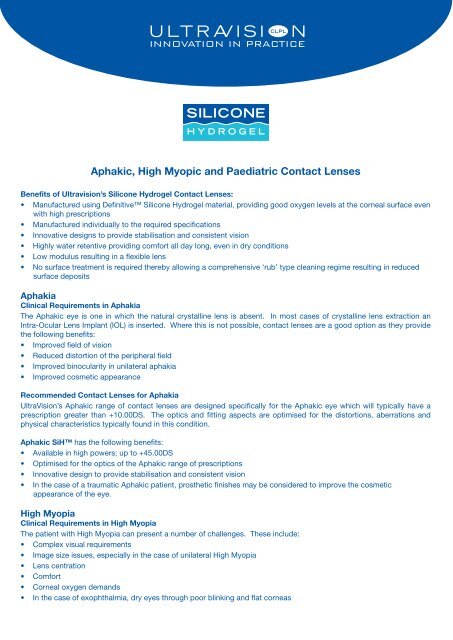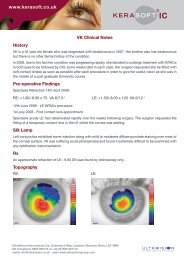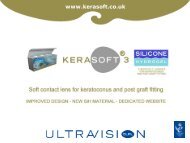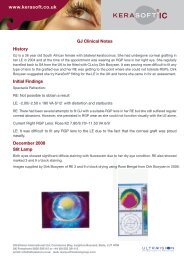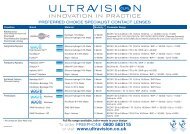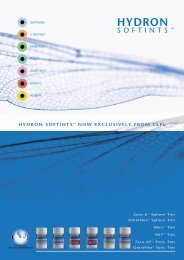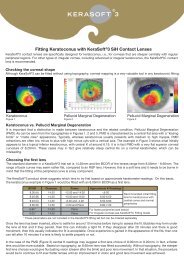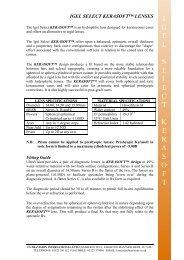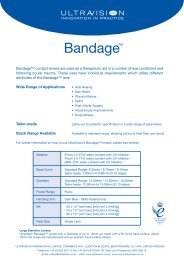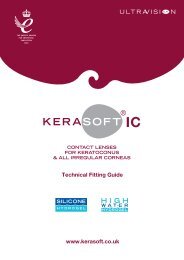Bandage Lens - UltraVision Group
Bandage Lens - UltraVision Group
Bandage Lens - UltraVision Group
Create successful ePaper yourself
Turn your PDF publications into a flip-book with our unique Google optimized e-Paper software.
Aphakic, High Myopic and Paediatric Contact <strong>Lens</strong>es<br />
Benefits of Ultravision’s Silicone Hydrogel Contact <strong>Lens</strong>es:<br />
• Manufactured using Definitive Silicone Hydrogel material, providing good oxygen levels at the corneal surface even<br />
with high prescriptions<br />
• Manufactured individually to the required specifications<br />
• Innovative designs to provide stabilisation and consistent vision<br />
• Highly water retentive providing comfort all day long, even in dry conditions<br />
• Low modulus resulting in a flexible lens<br />
• No surface treatment is required thereby allowing a comprehensive ‘rub’ type cleaning regime resulting in reduced<br />
surface deposits<br />
Aphakia<br />
Clinical Requirements in Aphakia<br />
The Aphakic eye is one in which the natural crystalline lens is absent. In most cases of crystalline lens extraction an<br />
Intra-Ocular <strong>Lens</strong> Implant (IOL) is inserted. Where this is not possible, contact lenses are a good option as they provide<br />
the following benefits:<br />
• Improved field of vision<br />
• Reduced distortion of the peripheral field<br />
• Improved binocularity in unilateral aphakia<br />
• Improved cosmetic appearance<br />
Recommended Contact <strong>Lens</strong>es for Aphakia<br />
<strong>UltraVision</strong>’s Aphakic range of contact lenses are designed specifically for the Aphakic eye which will typically have a<br />
prescription greater than +10.00DS. The optics and fitting aspects are optimised for the distortions, aberrations and<br />
physical characteristics typically found in this condition.<br />
Aphakic SiH has the following benefits:<br />
• Available in high powers; up to +45.00DS<br />
• Optimised for the optics of the Aphakic range of prescriptions<br />
• Innovative design to provide stabilisation and consistent vision<br />
• In the case of a traumatic Aphakic patient, prosthetic finishes may be considered to improve the cosmetic<br />
appearance of the eye.<br />
High Myopia<br />
Clinical Requirements in High Myopia<br />
The patient with High Myopia can present a number of challenges. These include:<br />
• Complex visual requirements<br />
• Image size issues, especially in the case of unilateral High Myopia<br />
• <strong>Lens</strong> centration<br />
• Comfort<br />
• Corneal oxygen demands<br />
• In the case of exophthalmia, dry eyes through poor blinking and flat corneas
Contact lenses can provide the wearer with an excellent solution to their visual needs. The benefits of contact lenses<br />
are:<br />
• Improved field of vision<br />
• Reduced distortion of the peripheral field<br />
• Improved binocularity in anisometropia<br />
• Increased image size leading to improved visual acuity (when compared with spectacles)<br />
Recommended Contact <strong>Lens</strong>es for High Myopia<br />
<strong>UltraVision</strong>’s High Myopic SiH contact lens is recommended for Myopic wearers with a prescription greater than<br />
-10.00DS.<br />
High Myopic SiH has the following benefits:<br />
• Available in high powers; up to -45.00DS<br />
• Optimised for the optics of the High Myopic range of prescriptions<br />
• Reduced front optic diameter (FOD) which is calculated for each individual combination of prescription and lens<br />
diameter, resulting in the thinnest lens possible to increase oxygen flow to the cornea and to provide excellent<br />
comfort<br />
Alternative <strong>Lens</strong>es for High Myopia and Aphakia<br />
Aphakic SiH and High Myopic SiH are the preferred choice of lens as they are optimised for these uses.<br />
Alternative lenses are:<br />
• HydroWave®<br />
HydroWave®, also made using Silicone Hydrogel material, incorporates <strong>UltraVision</strong>’s award winning wavefront<br />
technology. HydroWave® is available with the option of a front surface toric, with cyls up to -11.00DC.<br />
• Eureka Asphere RGP<br />
Eureka Asphere is a rigid gas permeable (RGP) lens with an aspheric design, incorporating <strong>UltraVision</strong>’s award<br />
winning SAM® aberration management.<br />
• Xtralens RGP<br />
Xtralens is a rigid gas permeable (RGP) lens with a facility to allow the practitioner to configure the lens lift or drop.<br />
This feature is used to fine tune RGP lens centration for high powered lenses.<br />
Paediatric Cases<br />
Clinical Requirements for the Paediatric Patient<br />
Infants and young children may need contact lenses for refractive reasons or for use in some pathological conditions. The<br />
most common cause for contact lens fitting in infants is aphakia, following the removal of congenital cataracts. However<br />
other applications for paediatric contact lenses include high myopia, anisometropia, strabismus, photophobic conditions,<br />
post-trauma and post-operative care.<br />
Recommended Contact <strong>Lens</strong>es for Paediatrics<br />
<strong>UltraVision</strong>’s Paediatric SiH contact lens is recommended as the first choice for paediatric applications due to the<br />
following benefits:<br />
• Designed specifically for the smaller eye, whilst ensuring good stabilisation and centralisation of the lens<br />
• Optimised for the specialised fitting, insertion and removal requirements of the paediatric patient<br />
• Designed to give consistent vision for the developing eye<br />
• Available in high powers; up to ±45.00DS<br />
Alternative <strong>Lens</strong>es for Paediatric Use<br />
Paediatric SiH is the preferred choice of lens as it is optimised for paediatric cases, both with respect to design and<br />
material. Alternative lenses for paediatric wearers are:<br />
• Simplon Paediatric are soft lenses available in a high water content material using our established paediatric design.<br />
• Astigmatism is rarely corrected fully in the young infant. As the eye develops toric lenses may be required, in which<br />
April 2009<br />
ULTRAVISION INTERNATIONAL LIMITED, COMMERCE WAY, LEIGHTON BUZZARD, BEDFORDSHIRE, LU7 4RW, UNITED KINGDOM<br />
Telephone: +44 (0)1525 381112 Fax: +44 (0)1525 370091 UK Order Line (Freephone): 0800 585115<br />
Email: orders@ultravision.co.uk Web: www.ultravision.co.uk; www.kerasoft.co.uk; www.siliconehydrogel.co.uk


